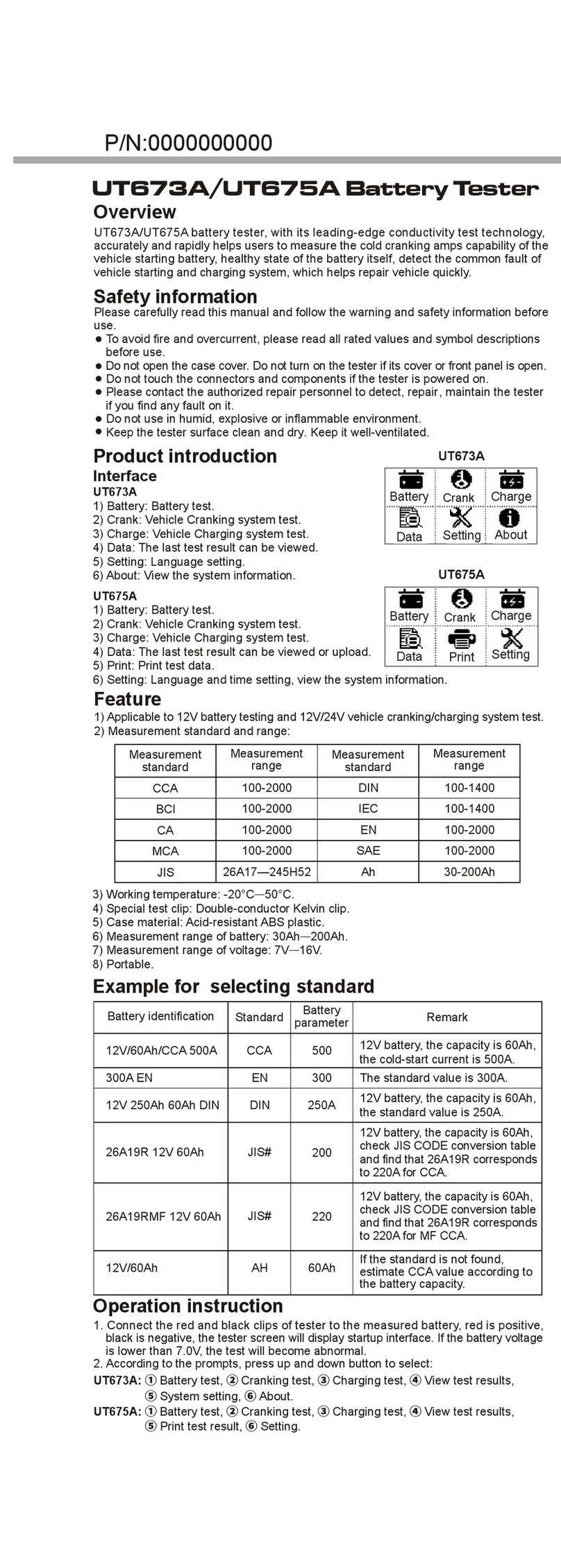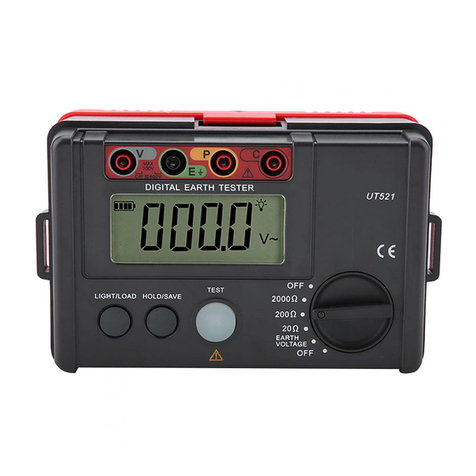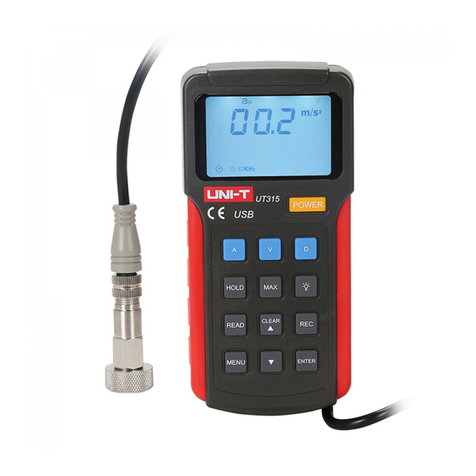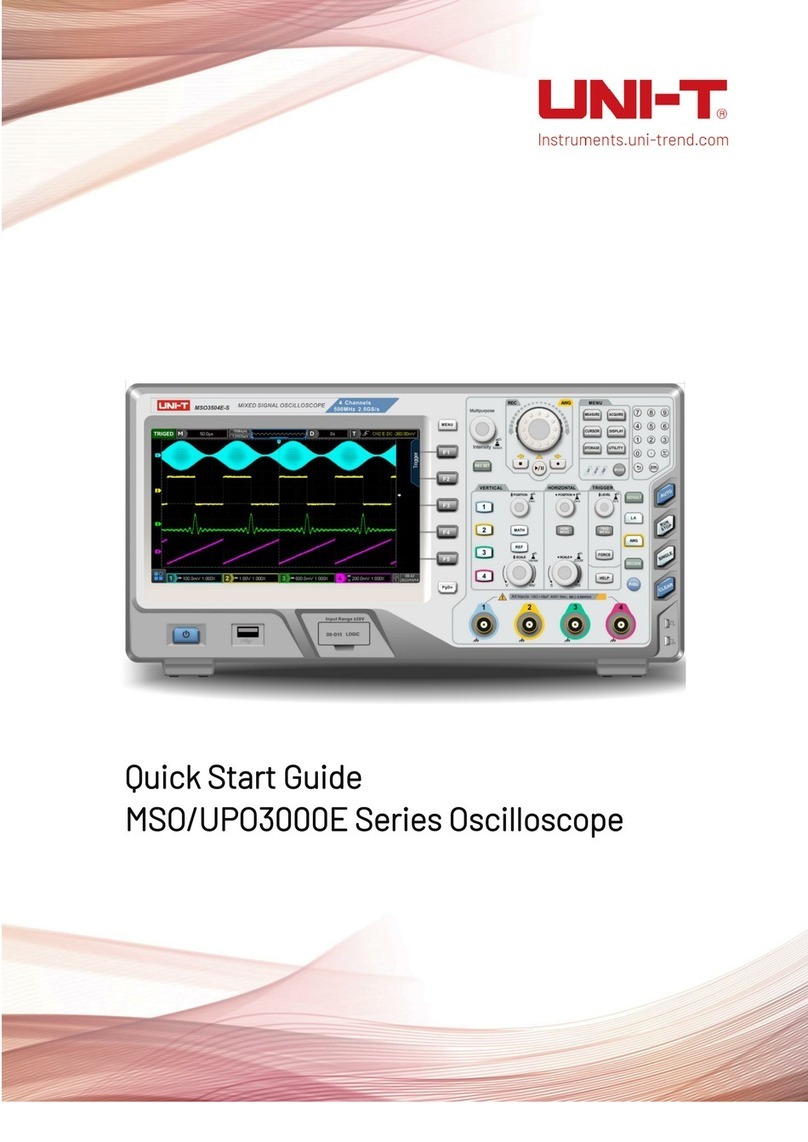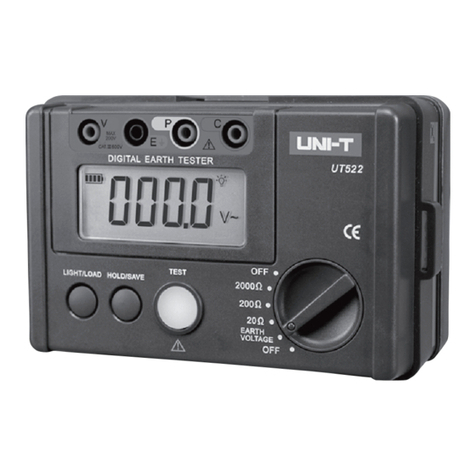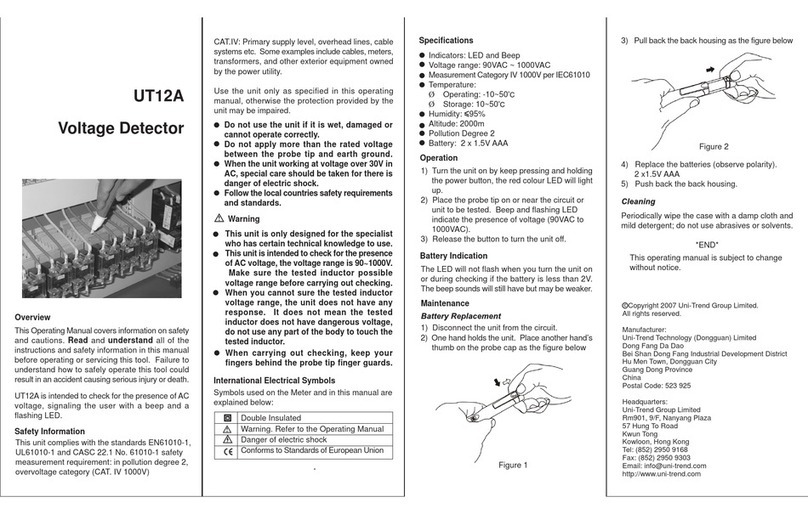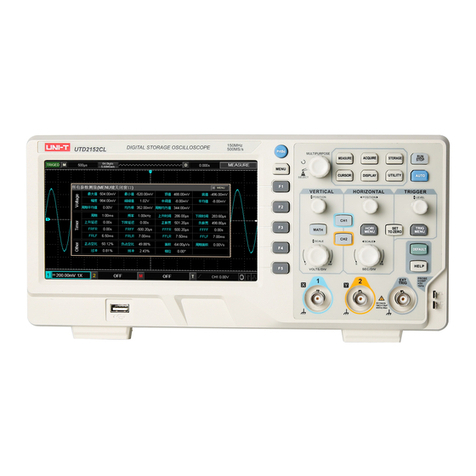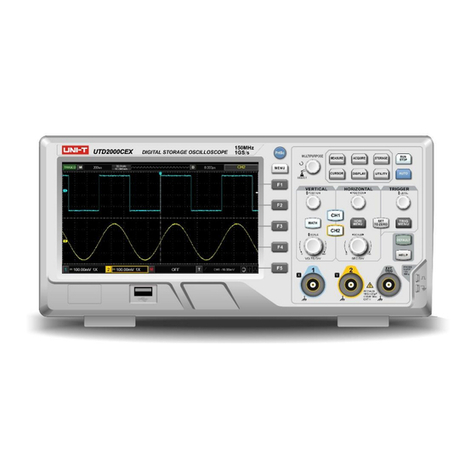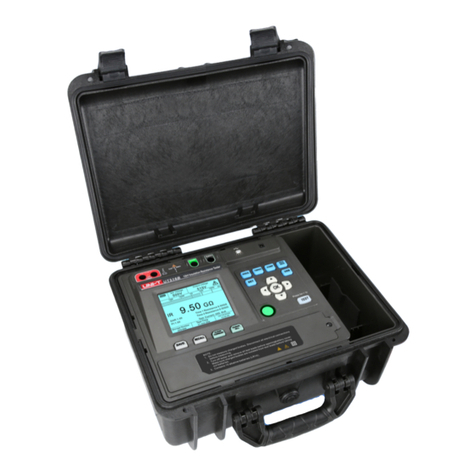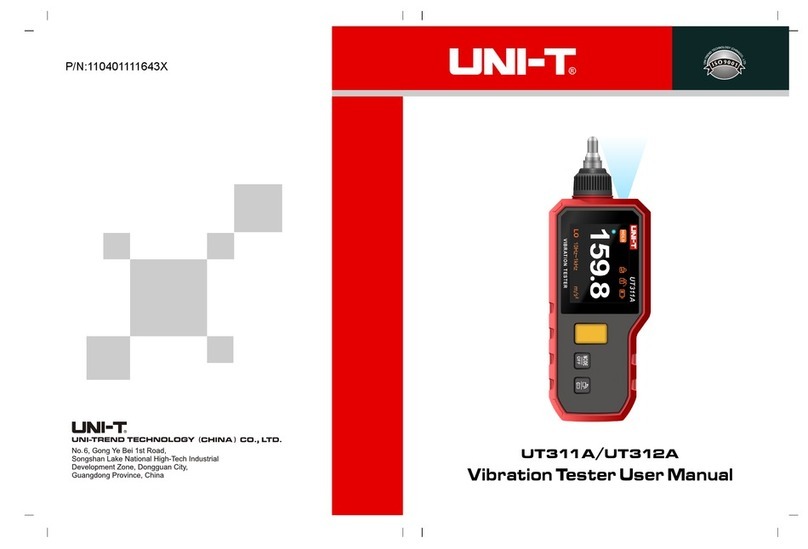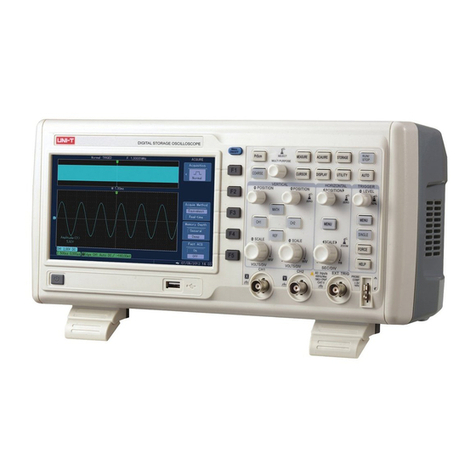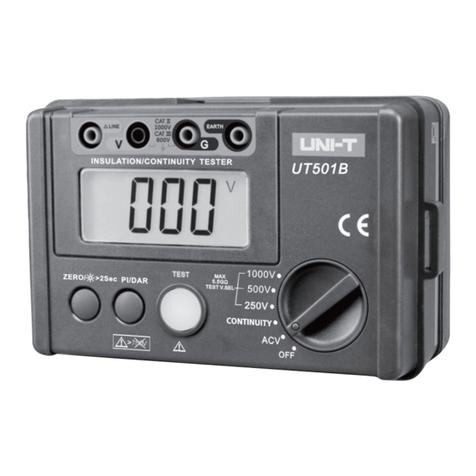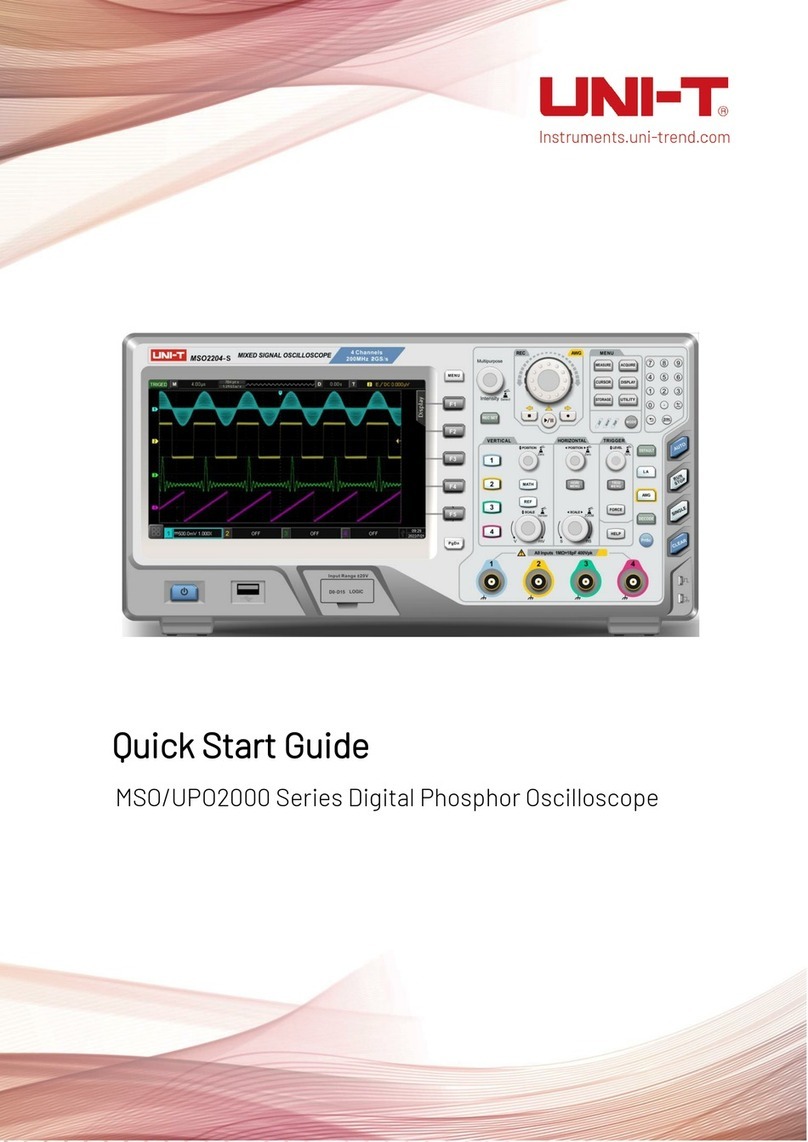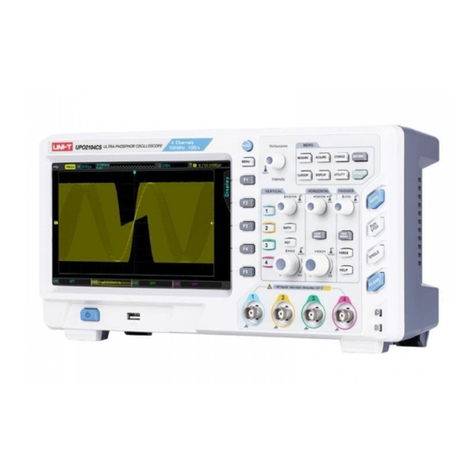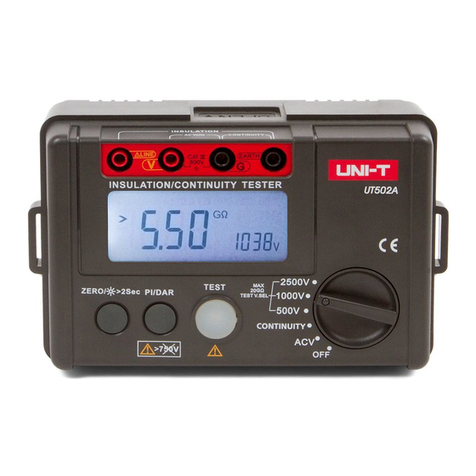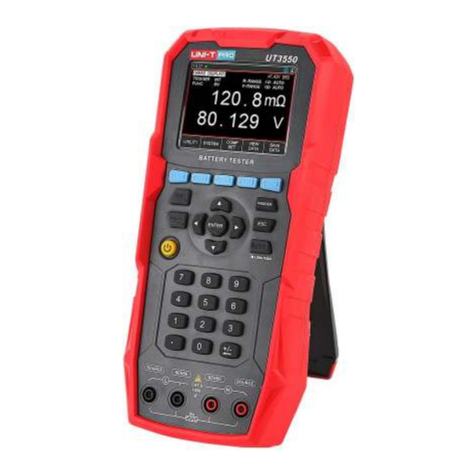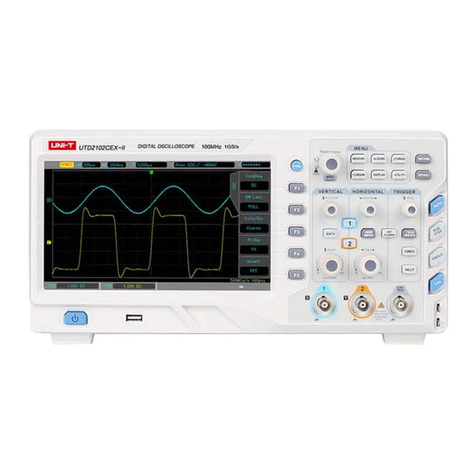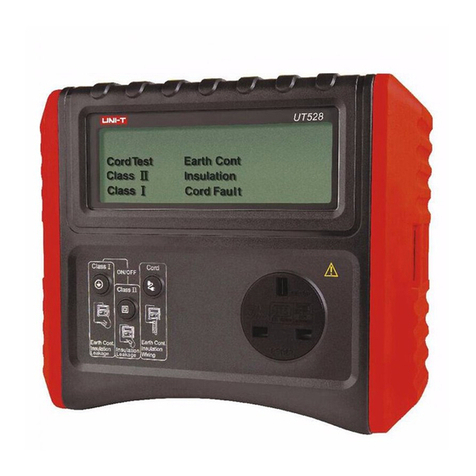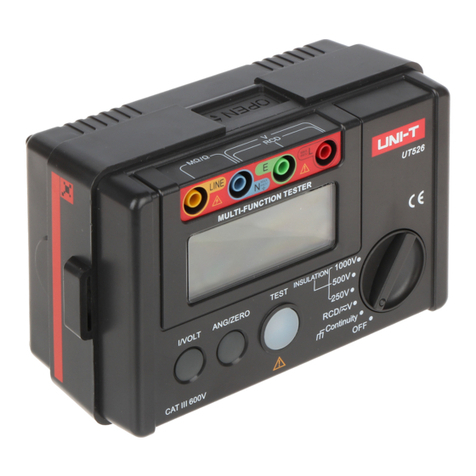Introduction
Uni-Trend Model UT512 insulation resistance tester
(hereafter, "the Meter") is a handheld instrument
designed primarily to make resistance/ insulation
resistance measurement.
Unpacking the Meter
The Meter includes the following items:
Table 1. Unpacking Inspection
Item
1
2
3
4
5
6
7
8
9
Description
English Operating Manual
One-plug test lead to one alligator
clip ( Black )
One plug test lead to one alligator
clip ( Green )
Two-plug test lead to one
alligator clip ( Red )
1.5V Battery (LR14 / R14)
Tool Box
USB Interface Cable
Software
Power adaptor (input voltage
230V, 50/60Hz, 50mA, output
DC14.5V, 600mA) (optional,
available at extra cost)
Qty
1 pc
1 pc
1 pc
1 pc
8 pcs
1 pc
1 pc
1 pc
1 pc
In the event you find any missing or damage, please
contact your dealer immediately.
Safety Information
This Meter complies with EN 61010-1:2010 safety measurement
requirement:Pollution Degree 2, measurement
category CAT III 600V and Double Insulation.
CAT II (measurement category): Test and measuring
circuits connected directly to utilization points (socket outlets
and similar points) of the low-voltage MAINS installation.
Use the Meter only as specified in this operating manual,
otherwise the protection provided by the Meter may be
impaired.
Dangeridentifies conditions and actions that pose
hazard(s) to the user.
Warning alerts users to avoid electric shock.
Cautionidentifies conditions and actions that may
damage the Meter and affect accurate
measurement.
Danger
Use of instrument in a manual not specifed by the
manufactuer may impair safety features/protection
provided by the equipment. Read the following
safety information carefully before using or
servicing the instrument.
Do not apply more than 600V.
Do not use the Meter around explosive gas,
vapor or dust.
Do not use the Meter in a wet environment.
When using the test leads, keep your figures
away from the lead contacts. Keep your
figures behind the finger guards on the leads.
Do not use the Meter with any parts or cover
removed.
Operating Caution identifies conditions that user
needs to take extra care during operating the Meter
Warning
Do not use the Meter if it is damaged or metal
part is exposed. Look for cracks or missing
plastic.
Be careful when working above 33V rms, 46.7V
ac rms or 70V DC. Such voltages pose a shock
hazard.
Discharge all loading of circuit under test after
measuring high voltage.
When carrying out insulation measurement,
do not contact the circuit under test.
Caution
When performing resistance tests, remove all
power from the circuit to be measured and
discharge all the power.
When servicing the Meter, use only only the
test leads and power adaptor with the same
model number or identical electrical
specifications.
Do not use the Meter if the battery indicator
() shows a battery empty condition. Take
the battery out from the Meter if it is not used
for a long time.
Do not use or store the Meter in an
environment of high temperature, humidity,
explosive, inflammable and strong magnetic
field. The performance of the Meter may
deteriorate after dampened.
Soft cloth and mild detergent should be used
to clean the surface of the Meter when
servicing. No abrasive and solvent should be
used to prevent the surface of the Meter from
corrosion, damage and accident.
Dry the Meter before storing if it is wet.
Risk of electric shock
Grounding
Empty of Built-In Battery
Conforms to Standards of European Union
International Electrical Symbols
International symbols on the Meter and in this manual
are explained in Table 2.
Table 2. International Electrical Symbols
Battery Saver (Sleep Mode)
The Meter enters the Sleep Mode and blanks the display
if there is no button press for 15 minutes. This is done
to conserve battery power. The Meter comes out of
Sleep Mode whenON/OFF button is pressed and hold
for 1 second.
Battery Indication
There is a battery indicator shown on the upper left corner
of the display. Please refer to Table 3 for detailed
explanation.
Battery Voltage
5.9V ~ 10.6V. It means the battery is
empty, Do not use the Meter as it
cannot
guarantee accuracy.
10.7V ~ 11.1V. It means the battery is
almost empty, replacing battery is
necessary. At this status, the Meter can
still output 500V and 1000V to measure,
the measured accuracy will not be
affected.
11.2V ~ 12.2V
12.2V or more
Table 3. Battery Indication
Battery
Indicator
The Meter Structure
Below Figure 1 and Table 4 shows the Meter front
structure and description
Do not change battery when the Meter is in
wet environment.
Place test leads in proper input terminals.
Make sure all the test leads are firmly
connected to the Meter's input terminals.
Make sure the Meter is turned off when
opening the battery compartment.
Figure 1. The Meter Front Structure
GreenBlackRed
1
2
3
4
5
6
7
8
9
10
11
12
13
14
15
16
Table 4. Meter Front Description
LCD
Arrow Button
Emergency Stop
Data Clear the Display Backlight Button
Arrow Button
On/Off Button
Compare Button
Insulation Resistance Button
DC Voltage Measurement Button
Timer Button.
AC Voltage Measurement Button
Test Button
USB Button
Data Store Button.
Data Recall Button
Arrow Button
17
18
19
20
21
22
Arrow Button
LINE: High voltage input terminal
( Connected to two-plug red test lead )
High voltage line shielding input terminal
( Connected to two-plug red test lead )
GUARD: Grounding protection input terminal
( Connected to one-plug black test lead )
EARTH: High resistance measurement input
terminal ( Connected to one-plug green
test lead )
Testing leads:
Two-plug red test lead to one alligator clip.
One-plug black test lead to one alligator clip.
One-plug green test lead to one alligator clip.
Below Figure 2 and Table 5 shows the Meter side
structure and description
Figure 2. The Meter Side Structure
Table 5. Meter Side Description
1 Safety Shutter
2 Power adaptor Input Terminal
3 USB Port
Display
Table 6 and Figure 3 describe the display.
Figure 3. Display
Table 6. Display Description
Number
1
2
3
4
5
6
7
8
9
10
11
Meaning
Analogue bar graph
Risk of electric shock
Battery life indicator
Indicator for timer
Timer 1 symbol
Timer 2 symbo
Indicates selected pass/fail compare value
Indicator for power adaptor
The continuity buzzer is on
Indicator for data store full
Data store is on
12
13
14
15
16
17
18
19
20
21
Data recall is on
Indicator for polarization index
Step symbol
Compare result: Pass
Compare result: Fail
Indicator for DC voltage
Indicator for AC voltage
Indicates negative reading
Unit symbols
Indicator for clearing
Table 7. Key Description
Turn on or off the Meter. Press and
hold the button for 1 second to turn the
Meter on. Press again to turn off the
Meter.
The Meter defaults at 500V range and
under continuous measurement of
insulation resistance when turned on.
Emergency stop button. Press this
button when the Meter crashes down
and cannot turn off the power.
Key Functions
ON/OFF
E-STOP
Short press to turn on or off the display
backlight
Long press to clear the stored data.
Press to store the current measurement
value. The maximum number of stored
reading is 18. When the stored readings
memory is full, the Meter shows FULL
and stop storing. Press and hold
CLEAR / to clear the stored value
in order to store the next measurement
CLEAR
/
SAVE
value.
LOADPress once to recall the first stored
value.
Press again to exit Load feature.
Load feature can only be used when
there is no high voltage output.
When the insulation resistance
measurement has no testing voltage
output, press to select previous voltage
range.
Under load mode: press to recall the
previous stored value.
When the insulation resistance
measurement has no testing voltage
output, press to select next voltage
range.
Under load mode: press to recall the
next stored value.
When setting the timer for the
measurement of insulation resistance
or polarization index, press to
decrement the time. The maximum
length of time is 15 minutes and 30
seconds, the Meter will automatically
carry out measurement.
When compare function is enabled for
insulation resistance measurement,
press to decrement a resistance
comparing value.
After polarization index measurement,
press to display polarization index,
TIME 2 and TIME 1 insulation
resistance values in sequence.
When setting the timer for the
measurement of insulation resistance
or polarization index, press to
increment the time. The maximum
length of time is 30 minutes and 30
seconds, the Meter will automatically
carry out measurement.
When compare function is enabled for
insulation resistance measurement,
press to increment a resistance
comparing value.
After polarization index measurement,
press to display polarization index,
TIME 2 and TIME 1 insulation
resistance values in sequence.
Press once to start the data
transferring to the computer via USB,
USB symbol shows on the display.
Press again to stop the data
transferring to the computer via USB,
USB symbol disappears.
USB
Set a pass / fail limit for insulation tests.
The default value is 10M
Press to step through continuous,
timed and polarization index
measurements in sequence.
Press to turn on/off the output of
insulation resistance test voltage.
Press to initiate insulation resistance
measurement
Press to initiate DC voltage
measurement
Pres to initiate AC voltage
measurement
COMP
TIME
TEST
IR
DCV
ACV
Measurement Operation
This section explains how to make measurements.
Press and hold ON/OFF to turn on the Meter, press
again to turn off the Meter. The meter defaults at 500V
range and continuous measurement of insulation
resistance when turned on.
A. Measuring Voltage
Figure 4. Voltage Measurement
Red
Green
To avoid harm to you or damage to the Meter,
please do not attempt to measure voltages
higher than 600V or 600V rms, although
readings may be obtained.
Special care should be taken when measuring
high voltage.
Operating Caution
To measure voltage, set up the Meter as Figure 4 and
do the following:
Press DCV or ACV button to select DC voltage or
AC voltage measurement
1.
CAT III (measurement category): Test and measuring
circuits connected to the distribution part of the building’s
low-voltage MAINS installation.
Equipment protected throughout by DOUBLE
INSULATION or REINFORECD INSULATION
Direct current
Alternating current
Caution












